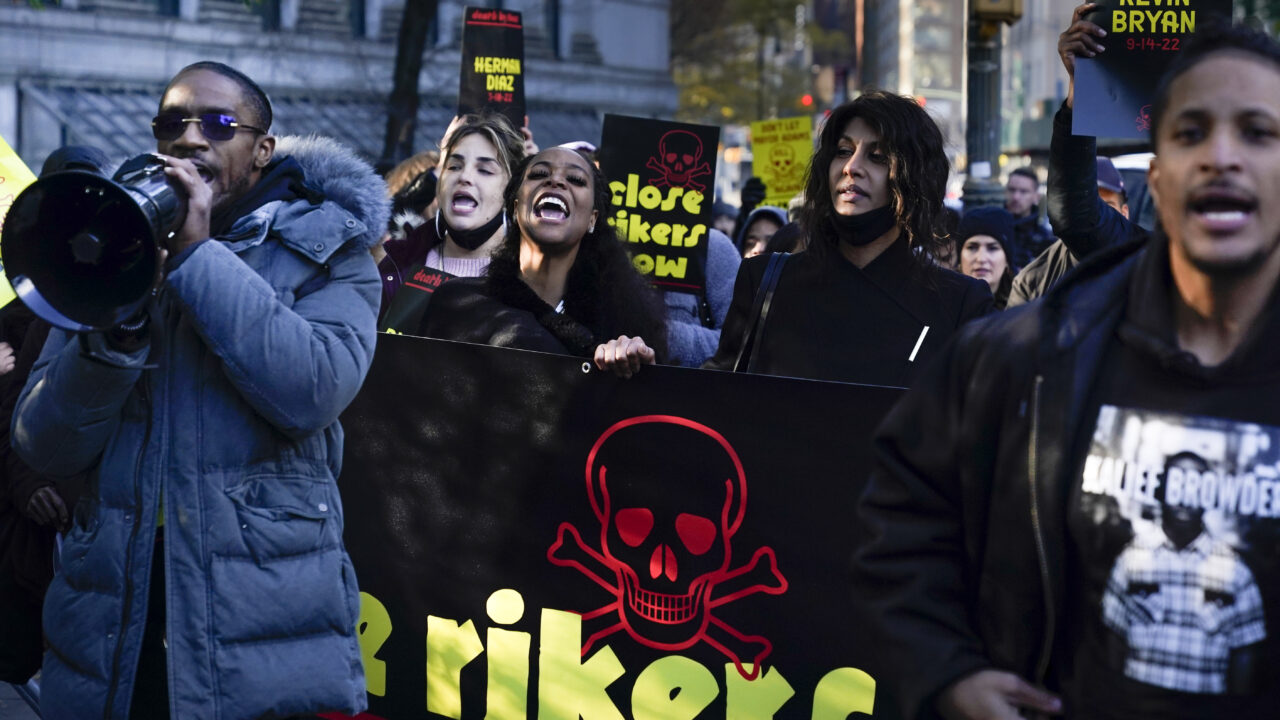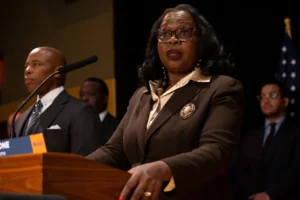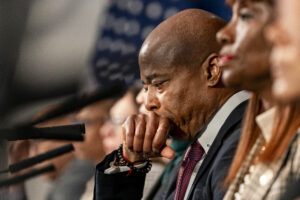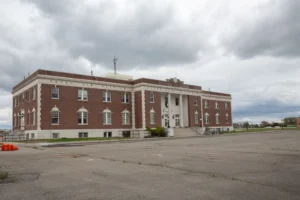How to Close Rikers
The dream of closing Rikers Island is stuck. We have a game plan to change that. Protesters march near the federal courthouse in New York, Thursday, Nov. 17, 2022. A hearing regarding control of Rikers Island brought out activists to protest the mismanagement and deaths at the infamous jail complex. (AP Photo/Seth Wenig)
Protesters march near the federal courthouse in New York, Thursday, Nov. 17, 2022. A hearing regarding control of Rikers Island brought out activists to protest the mismanagement and deaths at the infamous jail complex. (AP Photo/Seth Wenig)
Editor’s note: The following story is co-published with The Game Plan.
In the fall of 2019, at the apex of the criminal justice reform movement, the New York City Council overwhelmingly voted to close Rikers Island jail complex. Nearly four years later, the closure process feels adrift, and people are questioning whether it will close on time (2027) or at all. The latest round of hellish headlines are prompting a federal judge to consider appointing a federal monitor to oversee the jails, but that would not necessarily result in the jail complex closing any faster. As a city and as a criminal justice community, we need a game-plan to actually close Rikers.
Scouting Report: The effort to close Rikers Island has been nearly a century in the making. Rikers has been notoriously corrupt and unmanageable since opening in the mid-1930s, and multiple efforts to “reform” it through the decades have failed. Not only is Rikers a horrible place, it’s also a living human rights violation. Most of the people held there are pre-trial detainees, meaning they are legally innocent, while others have been convicted of minor crimes or violating parole. (People convicted of serious crimes are sent to prison in upstate New York, not kept at Rikers.)
It means recognizing that even a short jailing can be extremely disruptive to a person’s job, housing, mental health, and family wellbeing. It means having a smaller jail system that is actually located next to the courthouse, with access to lawyers, as opposed to a bus system that fails to bring people to court 25% of the time. It means investing in real support services and other things that will make our communities safer instead of spending half a million dollars per person per year to lock someone up on Rikers.
The #CLOSErikers campaign launched in the beginning of 2016, and over the next few years aggressively pushed New York City politicians to wake up to the human rights atrocities happening in their own backyard. In 2017, the “Lippman Commission” issued a report calling for Rikers closure. Mayor de Blasio’s acquiescence soon followed. In early 2019, a coalition born out of the #CLOSErikers campaign (#FreeNewYork) passed legislation overhauling New York’s bail, discovery, and speedy trial laws – pretrial reforms that helped significantly reduce the jail population at Rikers. (Those looking for a deep dive can read my law review piece about this period.)
Closing Rikers and creating a system that is smaller, fairer, and safer means investing in programs to help people turn their lives around.
The 2019 City Council vote on closing Rikers was controversial. By some measures, the campaign to close Rikers had “won” sufficient political support by mid-2017, but for the next two years, City leadership slow-walked a convoluted land review process that made the vote to “close Rikers” more about authorizing four new jails (three of them to replace existing jails on the very same sites), one in each borough except Staten Island. The No New Jails opposition blended abolition with nimbyism, and the pressure played an important role in reducing the projected size of the new jails to 3,300 beds, an ambitious goal that would give New York City by far the lowest incarceration rate of any American city. For perspective, there were more than 20,000 people in NYC jails in the early 1990s, more than 10,000 when #CLOSErikers started, a low of 3,800 during COVID, and nearly 6,000 now. In most peer US cities, including LA, the incarceration rate is twice as high. For my part, my skepticism around the administration’s 10-year timeline (since validated!), lack of a mental health plan, and other concerns drove my opposition to the Council resolution. Since then I have maintained that in the absence of a politically viable, alternative plan, we need to see the 2019 plan through.
As slow as progress towards closure was during the de Blasio administration, at least the gears were in motion. Unfortunately, the 2021 election of Eric Adams was probably the worst possible outcome for closing Rikers. While others like Andrew Yang had “tough on crime” messaging in the mayoral race, Adams’ background as a cop gives him, deservingly or not, a louder megaphone on public safety issues. Adams’ administration is also congenitally disorganized, which is not ideal for a massive, complicated project like replacing Rikers with four borough-based jails. What was already slated as a $9 billion project may have as much as doubled in costs, and key dates have been missed.
Meanwhile, conditions on Rikers reached new lows during COVID, and a torrent of death, violence and workplace corruption unleashed during under Mayor Adams and Commissioner Molina followed, including attempts to neuter internal and external oversight in the jail system. No wonder the federal judge overseeing Rikers since a 2015 Department of Justice investigation is considering appointing a monitor to regulate the jails, a tool traditionally used to bring wayward police departments to heel. With this behavior from the Adams administration, one has to wonder how serious they are about implementing a closure plan they inherited from de Blasio, even with billions of dollars actively being spent on it.
We need a game-plan to make sure Rikers is actually closed on schedule and replaced with a system that is safer, smaller, and fairer, a system that is focused on strengthening communities by using the criminal justice system not merely to punish, but to turn peoples’ lives around.
1. Advocates need to find common ground again. At the campaign’s peak, a diverse coalition of 200 organizations were part of the effort to close Rikers. The distaste of using energy to push for new jail construction and the need for most groups to move on to other pressing issues has left behind a politically weaker coalition. It’s telling that organizers like Freedom Agenda’s Darren Mack (called “an Uncle Tom” in 2019), are still grinding away trying, while some of the campaign’s abolitionist critics have moved on. But common ground must always cut both ways. It’s imperative both that the Freedom Agenda and its partners do a better job reaching out to rebuild a broad coalition, and for abolitionists to direct their ire squarely at the Adams administration, if fully coming to the coalition table is not an option.
And if the borough-based jails plan will never have the same animating support as closing Rikers originally did, surely the movement can find surer common cause around improving mental health resources, pressuring District Attorneys, and other measures necessary to reduce the number of people in New York City jails. Perhaps more effort must go to centering families who have more recently lost loved ones there. But this campaign cannot move if the base of the social justice movement doesn’t support it.
2. Bring Back #BuildCommunities. The original campaign hashtag was #CLOSErikers / #BUILDcommunities – giving people an understanding of not only what is wrong, but what we need to do instead to make our communities safe. Right now the campaign to close Rikers is short on allies and momentum, so it should seek common ground with movements building that safety net – namely affordable housing. It’s the biggest policy conversation in New York for good reason.
3. Offer a serious mental health plan. New York City has become more reactionary on issues of public safety in the past few years, driven no doubt by the desolate streetscapes and subway platforms during COVID and the spike in crime (since receding) that followed. The mayor is no help here, fanning the flames of fear, and the local reaction to Daniel Penny’s killing of Jordan Neely is a discouraging marker of the city’s temperature. That means the effort to close Rikers must be part of the public safety conversation, and cannot dance around it. And there is no path to safely and significantly shrinking our jail population without addressing the crisis of mental health in New York City.
Unfortunately, the 2021 election of Eric Adams was probably the worst possible outcome for closing Rikers.
Fortunately, everyone from Governor Hochul to Mayor Adams to Council Speaker Adams is talking about increasing mental health support. I’m particularly keen on city funding to expand the Fountain House model. Even the Rikers closure plan specifically calls for 380 additional beds in Bellevue, Woodhull, and North Central Bronx, “therapeutic units” run by Health & Hospitals instead of DOC. (True to form, the Adams administration has fallen behind on this comparatively modest project.) I have been banging the drum for years that the City needs to develop the state-owned Creedmoor psychiatric hospital site, and convert some of the deinstitutionalized buildings to facilities with wrap-around services to support the many people in our jail system who have mental health or substance use problems. But even though politicians are now all talking about putting more money into mental health, I have yet to hear of a plan that will lead more people into the social work field, to deliver agency-funded or correctional mental health support.
Activists have been saying “mental health support, not jails” for years. It’s time to get serious, get granular, and get these programs in motion.
4. Get the lawsuits ready. There are open questions about the enforceability of the 2019 vote to close Rikers, and whether the 10-year timeline is legally relevant. Technically, there’s an argument that the 2019 legislation merely authorized the construction of four jails, not the closure of any. No New Jails folks have always made this point; while I can say with confidence that no relevant player in the de Blasio administration wanted this outcome, a worst case scenario of Rikers still being open after the new jails are built doesn’t seem off the table in an Adams administration.
Perhaps the more important legislation is the 2021 legislation transferring control of the island from DOC to DCAS by the end of 2027 to begin the “Renewable Rikers” project. If Rikers Island literally can’t be used as a jail, that should light a fire under the administration. But that pressure only exists if legal parties can force the city to follow the 2021 legislation, rather than ignoring it or slow-walking it. These are legal questions to explore now.
5. Target the Five District Attorneys. Commissioner Molina doesn’t send people to Rikers, judges do at the behest of our five DAs. There must be a focused carrot/stick effort to push each DA office to reduce the number of people it locks up pretrial. That means working with the defense bar to call out cases where DAs are unnecessarily asking for bail, but also praising them when they do good, like DA Bragg directing illicit bank money to mental health and homeless services. This year the Bronx and Queens District Attorney races passed without any discussion on these issues, which was a real missed opportunity, especially compared with the hoopla around the 2019 Queens race.
6. Engage federal stakeholders. Members of Congress representing New York City have both the political cache to move this issue forward against a recalcitrant mayor and the ability to steer resources to the City that can help build the alternative support systems needed to reduce the jail population.It’s a mistake that our federal electeds have largely been absent from the conversation around closing Rikers, even though today the most powerful Democrat in both the House and Senate hail from Brooklyn.
7. Use 2025. The single most effective set of tactics deployed by the original #CLOSErikers campaign in 2017 was to use Mayor de Blasio’s cakewalk of a reelection campaign to highlight Rikers. We showed up outside his debates (where I first met candidate AOC, who protested with us for 2 hours) and fundraisers. We showed up at his polling place, where 25 news outlets with nothing to do but stand around were happy to shoot B-roll and interview us. We confronted him at his gym. Adams is a little different than de Blasio in that he’s already in public constantly, but he’ll face more political scrutiny in the run-up to an election. That’s the time to make demands.
Note that all of this works even without an effective primary challenger in the mayor’s race. In 2017 we made #CLOSErikers the de facto primary challenger. But these tactics work even better if there is a credible opponent, especially if they are better on the issue of closing Rikers, as a progressive challenger likely would be. Either way, it’s not the challenger’s job to frame and highlight the issue, it’s the campaign’s, so planning for this should get underway now.
Postgame: This is a piece I’ve wanted to write for a long time, but each time the urge surfaced I channeled energy towards the players inside and outside of government who are best positioned to make change happen in this area. Sitting here halfway through 2023, I no longer believe Rikers will close without a new injection of energy, purpose, and will into the political conversation. It pains me to say that, as someone who work up every morning for two years focused on that mission. But I also know that when people light the right sparks, doors of opportunity open, and change can come pouring through. While the effort to close Rikers may be experiencing its darkest hours, morning will come, and everyone who believes in this cause needs to be ready.
Your support matters…Independent journalism is under threat and overshadowed by heavily funded mainstream media.
You can help level the playing field. Become a member.
Your tax-deductible contribution keeps us digging beneath the headlines to give you thought-provoking, investigative reporting and analysis that unearths what's really happening- without compromise.
Give today to support our courageous, independent journalists.






You need to be a supporter to comment.
There are currently no responses to this article.
Be the first to respond.